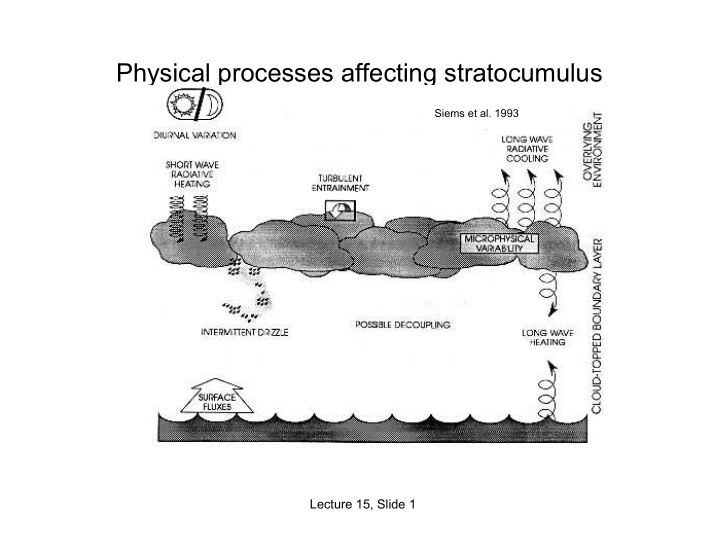



Physical processes affecting stratocumulus Siems et al. 1993 Lecture 15, Slide 1
Sc physical processes: Radiation Net upward radiative flux Strong longwave cooling at cloud top destabilizes SCBL, creating turbulence Shortwave heating in cloud cancels much of the longwave cooling during the day, weakening turbulence and favoring decoupling. Subtropical CBL radiative energy loss is usually large compared to surface heat flux. Diurnal cycle of net SCBL rad cooling Lecture 15, Slide 2
Profiles in a stratocumulus-capped mixed layer ‘ Well-mixed ’ : Moist- conserved variables s l = c p T + gz - Lq l , q t = q v + q l h = c p T + gz + Lq t are nearly uniform with height within the MBL. q l increases linearly with z above cloud base DYCOMS-II, July 2001 Stevens et al. 2003 QJ Lecture 15, Slide 3
Sc diurnal cycle of liquid water path and albedo The diurnal cycle of cloud albedo (solid) and liquid water path (circles) averaged over 23 Jun - 15 Jul 1987 at San Nicholas Island off the California coast during the FIRE-MSC experiment. Lecture 15, Slide 4
Decoupled SCBL - midday, North Atlantic. Lecture 15, Slide 5
Day vs. night profiles of turbulence in Sc-topped BL Mean daytime and nighttime vertical velocity variance profiles measured by a tethered balloon in June 1987 at San Nicolas Island off the CA coast during FIRE-MSC (Hignett 1991) . Lecture 15, Slide 6
SCBL diurnal cycle in SE Pacific sonde time series 3-hourly sondes show: 1. Mixed-layer structure with strong sharp inversion 2. Regular night-time increase in inversion height, cloud thickness. 3. Decoupling measured by cloud base - LCL increases during daytime and during periods of drizzle on 19, 21 Oct. (local noon = 18 UTC) (Bretherton et al. 2004) Lecture 15, Slide 7
Sc physical processes: Precipitation precip flux Drizzle: Drops > 100 µm radius, falling ~ 1 m s -1 . Sedimentation (in cloud only): z Cloud droplets less than 20 µm radius, falling a few cm s -1 . 1 mm/day EPIC 8-mm vertically pointing ‘ cloud radar ’ observations of drizzling Sc hourly cloud base hourly cloud top hourly LCL Comstock et al. 2004 Lecture 15, Slide 8
Sc physical processes: Turbulent entrainment w e flux - w e F + F + • Driven by turbulence Entrainment zone • Inhibited by a strong inversion F - ′ ′ = flux - w e F - + w F • Must be measured indirectly (flux- e jump or budget residual methods) ′ ′ = − w e Δ F w F e DYCOMS-II RF01 (Stevens et al. 2003): Flight thru nocturnal Sc-capped mixed layer Lecture 15, Slide 9
Budget residual method for estimating entrainment from ship obs A 6-day composite diurnal cycle of entrainment rate by SE Pacific Sc during EPIC 2001 (right) based on SCBL mass (black), moisture (blue) and heat budgets (red). All three estimates are qualitatively consistent, with strongest entrainment at night and typical magnitudes of 0-8 mm/s, but measurement uncertainties are large. Needed terms in the budget equations were deduced from radiosondes and ship-based observations of surface precipitation, radiative and turbulent fluxes. ECMWF Caldwell and Bretherton 2005 vertical motion was used in the mass budget and a clear- sky radiation calculation was used above the cloud layer. Lecture 15, Slide 10
Recommend
More recommend